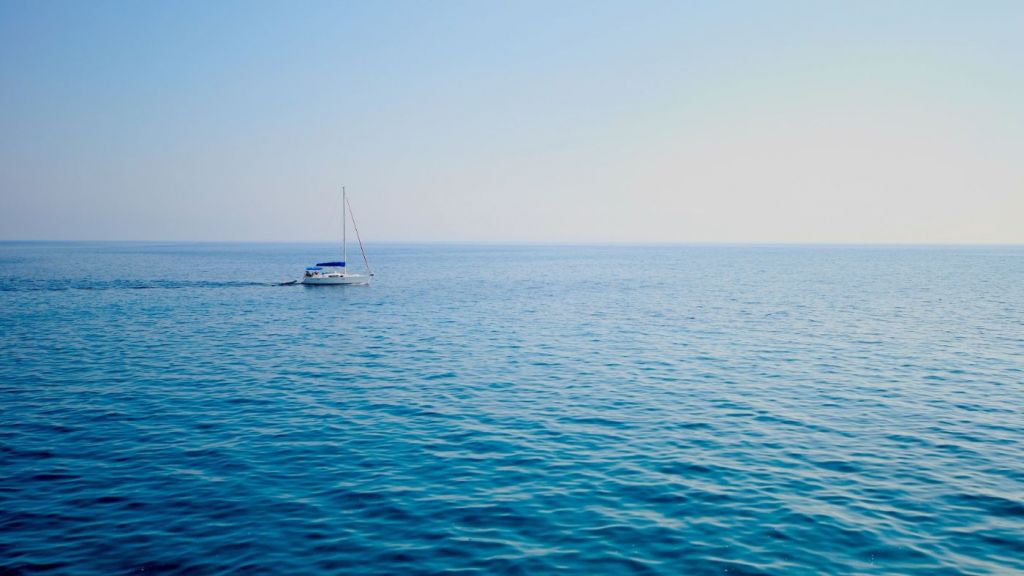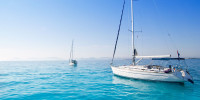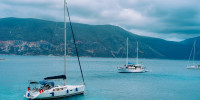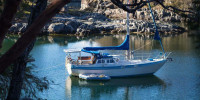How to Anchor a Boat in Deep Water (like the ocean)
When people find out that we make non-stop, multi-day passages offshore, inevitably someone with no sailing experience will ask, "How do you stop at night to sleep?" Or, "how do you anchor the boat in deep water?"
You can't anchor a boat if the water is deep. Because your anchor has to reach the bottom to stop the boat, if the water is too deep you can not anchor the boat.
But you can slow a boat down, and you can almost stop its forward motion. This is important for safety, so read on to learn a bit more about it.

Can You Anchor in the Ocean?
When we refer to "anchoring" a boat, we mean using an anchor tied to the boat to completely stop the motion of a boat. The anchor must touch the bottom for this to work. Not only must it touch the bottom, but you need some slack in the anchor rode (the rope or chain connecting the anchor to the boat) for the anchor to hold.
You can leave a well-anchored boat unattended, since it's not moving anywhere.
But the answer to anchoring the ocean is no, you can not anchor in water deeper than the length of your anchor rode, which is most of the open ocean. Not with a metal anchor, not with a "sea anchor." You cannot anchor a boat offshore in deep water. If you slow it with a sea anchor or by heaving to, you still need to keep a watch and you can't leave the boat.
How Deep Can You Anchor?
For good holding power, you want to let anchor rode from four to seven times the depth of the water. With all chain rodes, this can be closer to four. But rope/chain combination rodes need closer to seven times the depth.
For less than ideal conditions, you can use a lower scope ratio - we've spent the night on 3:1 scope in Bora Bora, when he had to anchor in 90+ feet of water for a night. In emergencies - such as keeping the boat from going ashore during an engine failure or other problem where you lose control of the boat, you may be forced to use less.
But practically , with all chain, the deepest you can anchor is a water depth 1/3 the length of your rode. With rope chain, it's 1/4 the length for a 4:1 ratio. That is for mild conditions, with light winds and no bad weather.
When we had 300' of chain in Bora Bora, our maximum depth was 100'. Though we really prefer to anchor in a lot less, and anything over 70' gives us pause and we don’t sleep well.
What is a Sea Anchor?
A sea anchor is a bit of a misnomer, because it isn't a true anchor. It's a device to slow a boat down. Most sea anchors are like underwater parachutes, though they may also be drogues in various configurations like towable cones or cups.
These devices are very hard to drag through the water. When you deploy one off the boat, it slows the boat down, but because it increases drag through the water. It can't actually stop a boat dead like dropping an anchor on to the bottom.
When would you use a sea anchor?
Sea anchors are tools in a storm management strategy. One danger of storms is high winds, and a boat in a big blow can get moving quickly. Even with bare poles, tropical storm force winds will move a boat at high enough speeds to risk losing control or wiping out. Coupled with enormous waves, out-of-control speeds compound the danger or getting rolled or swamped.
The sea anchor slows the boat down, taking several knots off the storm driven speed and restoring more control to the skipper. Used with heaving to, a storm anchor can slow a boat down to a slow drift of less than a few knots. This is one popular technique for riding out storms at sea.
Are there other ways to stop/slow the boat?
Heaving to is setting up your rudder and your sails with opposing forces to settle the boat into a comfortable, slow motion where she is barely drifting downwind instead of sailing quickly. It's a handy technique that all sailors should learn, because it can give you a break in nasty weather to rest and make repairs.
While the boat doesn't stay still, it won't heel and slam the same way it does sailing upwind, and you can go out on deck and deal with problems, or sleep and shower down below to get rest from fighting a blow. We like to heave to if we arrive at a new harbor at night, because we don't like to enter new harbors in the dark for the first time.
When you're ready to stop sailing and there's no place to anchor, it's an excellent technique to slow the boat to a crawl and catch your breath.
How do you Anchor in Deep Water?
Deep water anchoring isn't that different from shallow water anchoring, except you may need to use less rode than you'd like if it's too deep for proper scope.
Anchoring in water deeper than thirty feet, there are techniques you can use to get a better set. The risk in deep water is piling the chain up on the bottom before you've set the anchor, since the hook may not set properly.
To avoid this, look at our article on How to Anchor a Boat, in particular section 5 - "Drop it and Set it" and "The Drop" and "The Set" subsections. This describes the detailed steps to set your anchor well.
Dropping properly in deep water is the key to getting a proper set. In shallow water, you can just drift back on your anchor rode, then reverse to set it. There's little enough chain out that it won't make a pile on the bottom to worry about.
But in deeper water, it pays to only let out about three times the water depth or less, and drift back on it to stretch out the rode until you feel the anchor catch. Then you reverse back on it to get a good an initial set.
Only once you've done that initial set do you let the rest of the scope out, back down hard, and snub up/tie off the rode.
Did you find the answer to your specific question?
👍 3 👎 4




Leave a comment